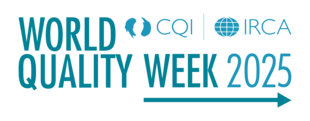
How to think differently: achieving effective alignment

In the second of a new three-part series, Rashad Issa, Chair, CQI Board of Trustees, shares insights on how effective alignment continuously drives value for organisations.
This year’s World Quality Week theme, ‘think differently,’ calls on professionals to focus on three key areas – people, alignment and performance. In my second blog, I’m taking a closer look at how horizontal and vertical alignment are crucial for organisational success.
Defining alignment
In an article published by the Henley Business School, Simon Lenton describes alignment as "... a state beyond agreement in which people embrace team decisions and organisational actions as though they are their own. Agreement is to consent to or go along with."
The article references definitions from Labovitz and Rosansky’s book, ‘The Power of Alignment’, which explains two types of alignment: vertical and horizontal alignment. Vertical alignment refers to the alignment of strategy between leaders and employees, while horizontal alignment focuses on the connection between customers and organisational processes.
Driving success through strategic alignment
When an organisation is committed to focusing on its customers, it must also focus on employees.
If we take the definitions of vertical and horizontal alignment, I think you'll agree that at the heart, this is quality management systems driving organisational success.
Rashad Issa, Chair, CQI Board of Trustees
Employees who are involved in strategic decision-making are more likely to commit to the success of the strategy than employees operating in a top-down approach only. Take, for example, John Lewis, a well-known UK brand that prides itself on its employee experience. Employees are known as partners who are committed to and drive the company's success.
Quality professionals are your business partners
Quality professionals are proven to be the partner who is exposed to your entire business operation as well as your customers. They may work on:
- internal audits – assessing the effectiveness of your processes against pre-agreed policies
- external audits – supporting your organisation to adhere to regulatory requirements and customer requirements
- business improvement projects – driving transformational projects either in stand-alone departments or in cross functional work to elevate visibility and drive resilience
- process improvement projects with the aim of reducing costs and increasing productivity giving you more resources to work with
Alignment spotlights
How does organisational alignment work in action? Below are a few key points to consider and tips to help ensure you can continuously drive value in your organisation.
Clarity:
- Is your company's strategy well understood?
- Is your quality strategy visible in the overall organisation's strategy?
- Is it simple and easy to understand?
- Does each project your team is working on link to a strategic goal and objective?
Agility: Operating in a volatile, uncertain, complex and ambiguous (VUCA) environment is the norm. This means your opportunities and risks are always evolving.
- Do you have visibility over your organisation's key risk indicators (KRI)?
- Have you established partnerships with divisions/process owners so that the KRIs are well defined and monitored?
- Can you shift your priorities to meet the demands of this changing environment?
Change in the environment can be structured as well as unstructured. For example, reviewing your voice of customer programme once a year is a great opportunity to assess if you are still getting value out of it, or whether the business needs to get a better sense of different aspects of your interactions. This is a structured approach.
An unexpected event could impact how you operate, leading you to promptly adjust your auditing programme from in person to virtual. Or having to pause an improvement project because the regulator introduced a new regulation that your organisation needs to adhere to can result in an unstructured response.
Do you have the mechanisms to operate in volatile, uncertain, complex and ambiguous environments and maintain visibility and clarity of your quality strategy?
Rashad Issa, Chair, CQI Board of Trustees
Success: Consider if you and your team can describe what success looks like. You may have heard the term critical success factors (CSF). This is a key step that allows you to work from the bottom up. This is where you bring clarity to your vision. Your team gets to describe what good looks like, even when there are changes in your context and operating landscape.
Asana (a work management platform) talks about the pyramid of clarity and how it helps teams operate in alignment. As a work platform, it helps you align your strategy to the single task a team member needs to do. The path of clarity combines mission, strategy, objectives (departmental, operational, commercial), measurable results, portfolios, projects, and tasks.
Thinking differently about alignment
If you are a business leader, next time you engage with your quality leaders, ask them what gaps they have identified. If you are focused on regulatory work, ask them what initiatives can be implemented to make compliance easier for operational teams.
If you are a quality professional, next time you connect with teams, write a report, or prepare a business unit presentation, ask yourself: is my report enabling business teams to deliver better? Does it include actionable items that would make their work more efficient and effective?
If you identified that your message focuses purely on adhering to or achieving compliance without the so-what factor, now is your time to think differently and start again. What should you do to reset?
Revisit the questions above and gather key information from your business to focus on the current context. It will pave the way for a successful shift; after all, you're the c-suite's business partner.
Rashad Issa, Chair, CQI Board of Trustees
I hope you found these strategies a useful guide to think differently for you and your teams. Read the first blog in this series here.
I look forward to continuing the quality conversation throughout the year and during World Quality Week in November.
Discover and use our World Quality Week tools and guides to elevate your quality practices and gain a competitive edge.
World Quality Week 2025: think differently

Join us to challenge traditional approaches to quality management and embrace new ways of thinking.
Become a member
Take your quality career to the next level by becoming a member of the CQI or an IRCA Certificated Auditor.
Discover Typical Competence Profiles

Typical Competence Profiles and Career Pathways Map, navigating your career pathway
